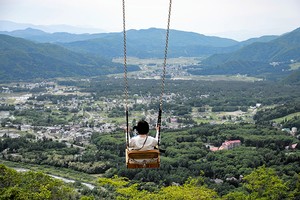By JUNKO SAIMOTO/ Staff Writer
July 19, 2023 at 07:00 JST
KYOTO—Open leaves on the juniper haircap moss give it a glossier appearance, while foam nests of eggs from forest green tree frogs hang from branches of camellias at the side of a pond.
Blue-and-white flycatchers and Japanese pygmy woodpeckers chirp over the murmur of a stream.
Sanzen-in may be famed for its autumn foliage, but the ancient temple in the Ohara district of Kyoto’s Sakyo Ward showed a different charm during the rainy season in mid-June.
“I like the beauty of this time of the year when plants and animals appear to be sparkling with life,” said Makoto Nomura, 67, who is in charge of maintenance of the temple grounds.
The temple is also famous for its moss garden featuring seven stone statues of “warabe jizo,” the guardian deity of children.
Created by sculptor Takashi Sugimura, the statues come in various designs. One lies on the ground, while others lean against each other.
They appear to be leisurely enjoying the sunlight emerging through the leaves while basking in complete serenity.
According to a study conducted by Masafumi Komatsu, a Kyoto Seika University professor specializing in psychoacoustics, juniper haircap moss covering a large surface area can absorb mid- and high-pitched frequencies that sound unpleasant to the human ear.
The moss-covered statues look quite old. But they were donated to the temple after the start of the Heisei Era (1989-2019), and the moss began to grow soon after their installation, according to temple officials.
With the clear Ryosen and Ritsusen streams running through the temple grounds, many tall trees grow in the garden.
“While there are fewer places where mosses can grow due to global warming and other factors, the temple grounds can provide appropriate amounts of light, shade and moisture, serving as a suitable environment for a wide variety of mosses,” said Yoshitaka Oishi, a Fukui Prefectural University professor well-versed in moss ecology.
Kojitsu Kobori, 69, who was appointed the 63rd head priest of Sanzen-in in 2021, said he was impressed by how Ohara district residents cherish plants and animals.
“Instead of being placed as ornaments, the statues blend in naturally with the garden,” Kobori said. “I think we are fascinated by how they exist in harmony with nature.”




















A peek through the music industry’s curtain at the producers who harnessed social media to help their idols go global.
A series based on diplomatic documents declassified by Japan’s Foreign Ministry
Here is a collection of first-hand accounts by “hibakusha” atomic bomb survivors.
Cooking experts, chefs and others involved in the field of food introduce their special recipes intertwined with their paths in life.
A series about Japanese-Americans and their memories of World War II